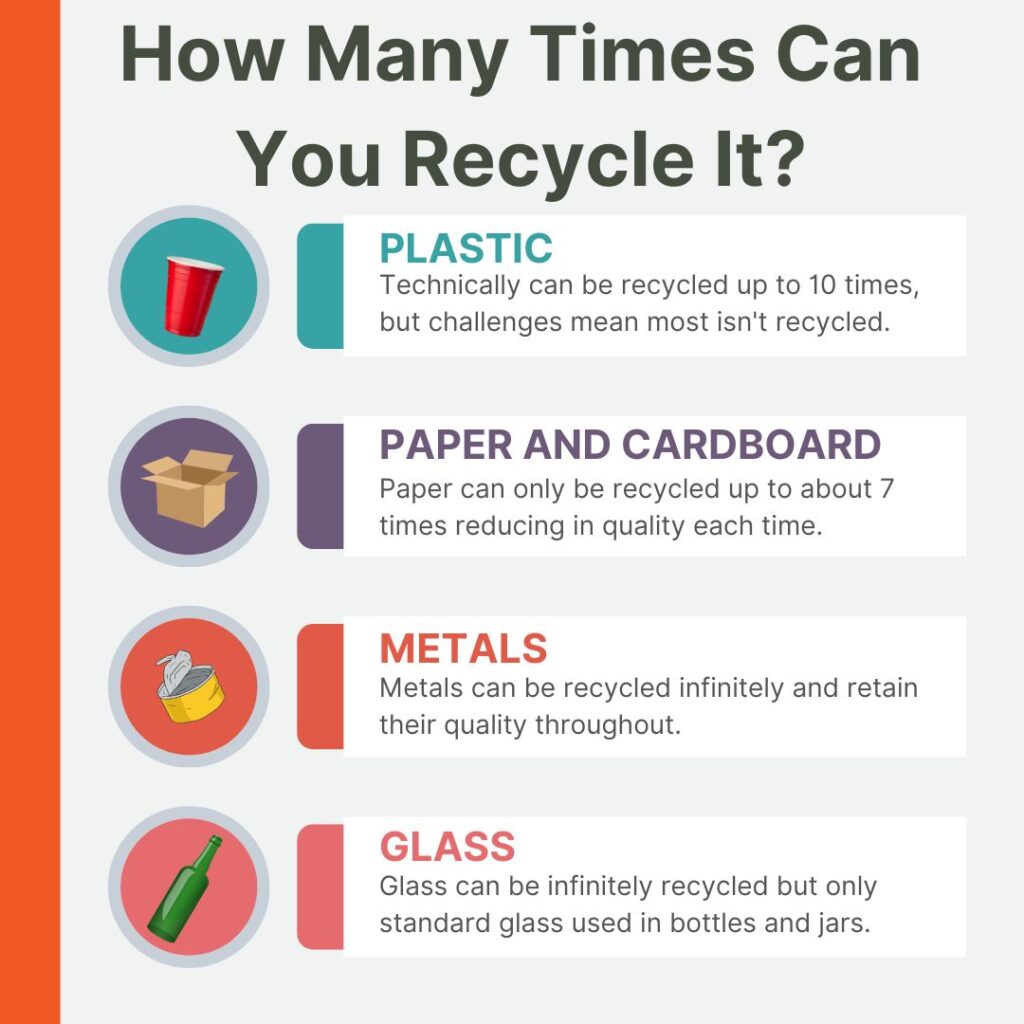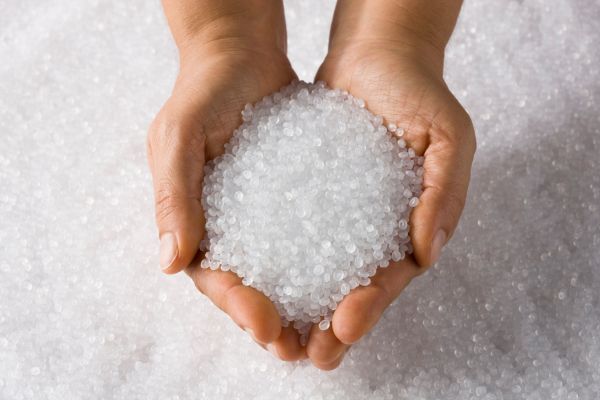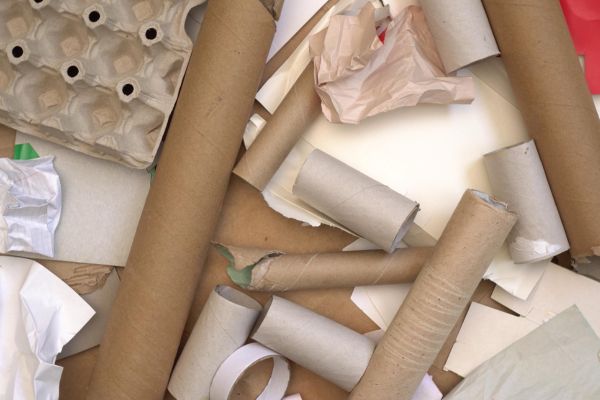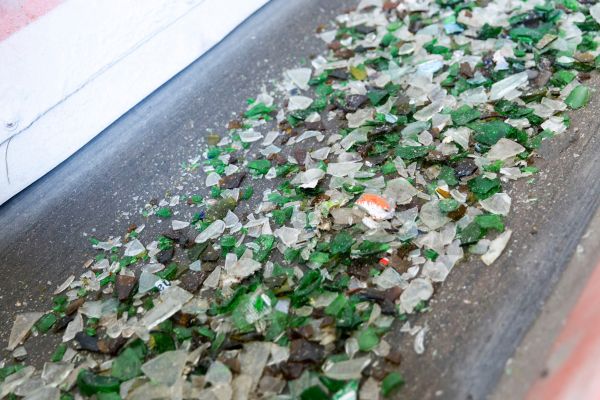Imagine a world where every discarded item gets a second chance at life, where plastic bottles become new containers, paper transforms into fresh sheets, and metal cans emerge as shiny appliances. This is the magic of recycling – a process that breathes new life into old materials, reducing waste and preserving resources. But have you ever wondered just how many times different materials can be recycled?
Join us on a journey through the recycling lifecycle as we unravel the mysteries behind plastic, paper, metal, and glass recycling.

How Many Times Can Plastic Be Recycled
Plastic, once celebrated for its versatility and convenience, now poses a significant threat to our environment. With over 8 million tons of plastic ending up in our oceans each year, it’s clear that action is urgently needed to address the plastic pollution crisis. However, recycling offers a glimmer of hope in mitigating this environmental catastrophe. But how many times can plastic be recycled?
Plastics can be recycled between zero and 10 times before the polymer chains degrade beyond use. In 2018, ESE World B.V. showed that HDPE can be recycled at least 10 times and possibly more, but this was only under controlled conditions. However, most plastics are lucky to get recycled at all, let alone 10 times.
Effectively recycling all plastic types is challenging due to collection, contamination and sorting issues. And according to recent studies by the Ellen MacArthur Foundation, globally, only 9% of all plastic ever produced has been recycled.
So where is the disconnect between recycling plastic up to 10 times and the reality that most plastic doesn’t get recycled?
While plastics like PET (Polyethylene Terephthalate) and HDPE (High-Density Polyethylene) are among the most commonly recycled plastics, challenges persist. Contamination and sorting issues plague recycling facilities, leading to inefficiencies in the recycling process. For other plastics like PVC (Polyvinyl Chloride) and PS (Polystyrene), the recycling rates remain dismally low, with only a fraction being effectively recycled.
The myriad of challenges faced by recycling systems include:
- Collection systems often lack uniformity and accessibility, hindering widespread plastic waste collection efforts.
- Inadequate sorting infrastructure results in contamination, rendering large quantities of collected plastic unfit for recycling.
- The market demand for recycled plastics is limited, as industries may prefer virgin materials due to perceived quality or cost concerns.
These factors collectively reduce the global plastic recycling rates, underscoring the urgent need for systemic changes and innovative solutions to address the plastic pollution crisis.
Unfortunately, many plastics are downcycled instead of recycled. Downcycling is when waste material is converted into a lower-quality or less valuable product. In many cases, this also means a product that cannot be easily recycled again. A common example is the use of rPET to make polyester clothing or accessories. Although the use of recycled material is a step in the right direction, these types of products are not easily recycled at the end of their life.
Despite these challenges, innovative solutions are emerging to improve plastic recycling rates. Advanced technologies, such as Near-Infrared (NIR) sorting and chemical recycling, show promise in effectively separating and recycling various plastic types, including those previously deemed unrecyclable. Furthermore, initiatives aimed at raising awareness about plastic pollution and promoting responsible consumption, such as the Plastic Pollution Coalition and the Break Free From Plastic movement, are gaining traction worldwide.
Are you ready to make a positive impact on the environment?
Our 10-day Curbside Recycling Challenge will help you to improve your recycling and positively impact the environment. Through daily tips and challenges, you’ll learn to sort materials and reduce contamination properly. By mastering curbside recycling, you’ll conserve resources, reduce waste, and play a vital role in the fight against pollution and climate change.

How Many Times Can Paper Be Recycled
Paper and paperboard, often hailed as the unsung heroes of recycling, indeed possess a commendable position in the recycling landscape due to their well-known recyclability. However, you might be surprised to learn that paper is not infinitely recyclable. According to the Environmental Protection Agency (EPA), paper and cardboard can only be recycled up to 7 times before the fibers become too short for reuse.
With each recycling cycle, paper fibers undergo degradation, resulting in a loss of quality. As a result, the recycled paper produced after multiple cycles may be of lower quality and may not meet the same standards as virgin paper.
According to studies conducted by organizations like the Paper Recycles Business Council (PRBC), the quality of recycled paper diminishes with each recycling iteration, leading to potential limitations in its usability for certain applications. Despite this, more paper and paperboard are collected and recycled than any other packaging material, so don’t stop recycling your paper and paperboard.

How Many Times Can Metals Be Recycled
Metal is the backbone of many industries. Its recyclability sets it apart from many other materials. According to the Institute of Scrap Recycling Industries (ISRI), metal, particularly aluminum, can be recycled infinitely without any loss of quality.
For instance, aluminum cans, one of the most commonly recycled metal items, can undergo an indefinite number of recycling rounds, maintaining their integrity and quality with each cycle. Additionally, the energy savings associated with metal recycling are substantial. ISRI reports that each round of recycling aluminum cans saves up to 95% of the energy required to produce new metal from raw materials.
This significant energy conservation not only reduces the environmental footprint of metal production but also contributes to mitigating greenhouse gas emissions associated with energy-intensive manufacturing processes.

How Many Times Can Glass Be Recycled
Glass, with its timeless elegance, is a recycling champion. The Glass Packaging Institute reports that glass can be recycled endlessly without loss of purity or quality. From wine bottles to jam jars, each glass container can be melted down and reshaped into new products, making glass recycling a shining example of circular economy principles.
Glass seems to stand as a recycling champion with remarkable recyclability. According to the Glass Packaging Institute (GPI), glass can be recycled endlessly without any loss of purity or quality.
However, it’s important to note that while glass is highly recyclable, not all glass is suitable for recycling. Many glass products, especially those used for specialized purposes like heat-resistant cookware or decorative glassware, undergo treatments such as heat treatment or have additives that render them non-recyclable.
Additionally, despite its recyclability, glass poses logistical challenges due to its weight and low demand in certain markets. The heavy weight of glass makes transportation and processing more energy-intensive and costly, which can deter recycling efforts in some regions.
The demand for recycled glass varies, and in areas where demand is low, much of the collected glass may end up being landfilled or used for lower-value applications like using it as fill or in roads instead of being recycled into new products. Therefore, while glass recycling offers significant environmental benefits, addressing these challenges is crucial to maximizing its potential as a sustainable material in the circular economy.

Final Thoughts
Importance of Learning About Recycling: Understanding the recycling lifecycle is crucial for anyone curious about reducing their environmental footprint. Books like “Recycling for Dummies” by Everyday Recycler provide valuable insights into recycling practices and empower readers to become conscious consumers. By learning about recycling, we can make informed choices and contribute to a more sustainable future for generations to come.
As we unravel the mysteries of recycling, one question lingers: How can we maximize the potential of recycling to build a greener world? The answer lies in our hands – through education, action, and a commitment to sustainable living. Let’s embark on this journey together and pave the way for a brighter tomorrow.














